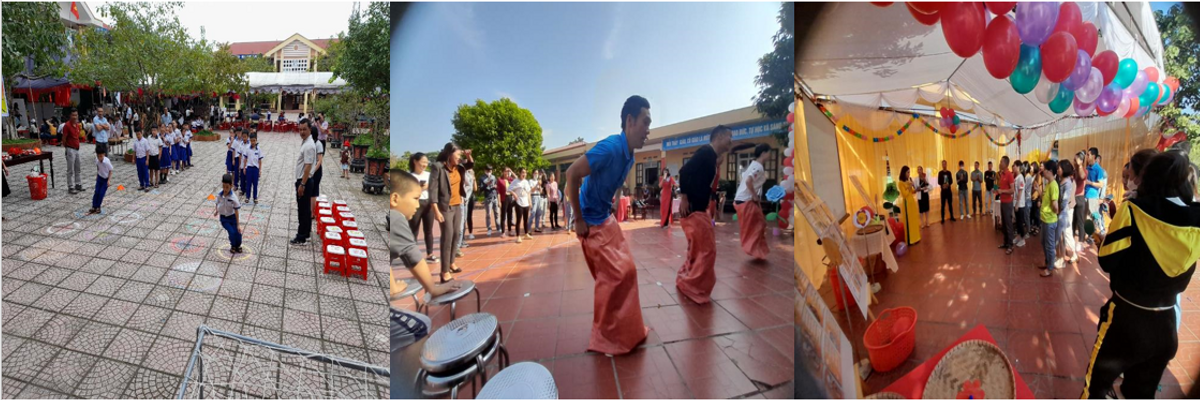
Learning Through Play Festival is an extracurricular activity held at elementary schools. Parents and students participate in fun, useful activities to learn about Learning through Play, the benefits of Learning through Play, and are guided by teachers to apply simple activities at home with their children, contributing to their hoslistic development.
"" - iPLAY Project: Integrating Learning through Play in primary education in Vietnam (VVOB Organization)

The program lasts 1.5 - 2 hours.
Work
Learn about Learning through Play:
Suggestions on how to organize
Organize a game of hopscotch to learn about HTQC:
>> When groups choose an explanation card for each content, they will paste it into the corresponding sections of the A0 paper.
The group with the most correct answers will receive a small gift.
Utensils/equipment, vpp
- A0 paper
-Concept name card, name of 5 characteristics, name of 4 principles.
- 1 card explaining the concept content, 5 cards explaining the content of the 5 characteristics of the quality system, 4 cards explaining the content of the 4 principles
-Projector, computer (if any).
-Small gift (can be a pencil, eraser, notebook...)
Work
Learn about the benefits of LTP for student development
Suggestions on how to organize
In your opinion, what are the benefits of Learning through Play for children? What areas/skills do you develop for children?
( Or the teacher places cards with 5 benefits written in the following positions: 2 cards “Cognitive Development” and “Creative Development” above the child's head; 2 cards “Develop social skills” and “Emotional Development” near the child's heart; “Physical Development” card near the child's feet. Then ask parents to place their cards in the corresponding areas on the picture according to their understanding.)
Work
Learn about organizing LTP activities at home
Suggestions on how to organize
Organize the activity "Mix and match" to learn about LTP activities at home:
01 set of cards with names of 05 student development areas:
The remaining 01 set of cards - 10 cards with the names of 10 LTP activities that parents can organize at home with their children to help them develop 05 areas (each area - has 2 activities).
(Refer to preparation documents in Appendix 3).
In addition to activities organized for parents to learn about Learning through Play, schools can organize activities aimed at comprehensive development for students in the school yard to create a fun and exciting atmosphere. for parents and students when participating in the Learning through Play festival. In addition, the school can organize play activities with coordination between parents and children.
1. Physical development:
Includes motor control activities, the ability to coordinate body parts (legs, arms...), reflexes and awareness of one's own body's abilities and limits such as endurance, strength and endurance. resilient.
Age-appropriate physical activities:
Sack jumping, hopscotch;
Rope skipping,
Tug
Kick the ball into the goal
2. Cognitive development.
Includes activities that help children increase their ability to observe, think, evaluate and solve problems...
Activities for children to read stories, tell stories, and act out plays in many different ways
For example:
Children listen or read storybooks, then draw the story they read or use cloth puppets or other toys to retell the story with their friends.
3. Develop social skills.
Includes activities to help children enhance teamwork coordination,...
Activities that require coordination among group members:
For example:
There are 2 groups of students standing in 2 rows. Each group has 1 ball. The first member passes the ball to the second person and the second person passes it to the next person. Pass it in turn until the last person. The last person quickly ran up and put the ball into the basket. After 3 rounds, the group that puts more balls into the basket will be the winner.
4. Develop emotional skills.
Includes activities that help children express emotions and thoughts in a healthy way...
Activities help children identify, name emotions and express emotions
For example:
Draw your own faces of happy, sad, angry, surprised people... on cardboard or large pebbles;
Or children make their own cloth dolls and decorate the doll's face with emotions of happiness, sadness, anger, surprise, etc. on the doll's face.